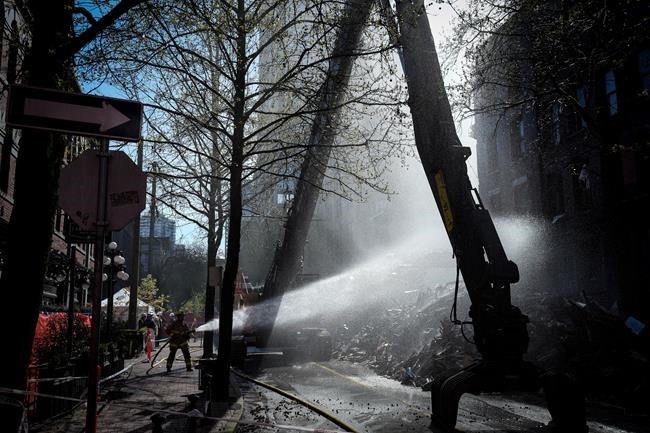Jesse Smith described the loud noise in the burning Winters Hotel in Vancouver as people were streaming out when she went back to help others and their pets escape.
"It's wood. So, you could hear just wood burning," she told a coroner's inquest on Friday.
She had been in the rooming house that day in April 2022 working for a program that supported tenants with pets.
Smith stood in the atrium, just for a few seconds, shooting video of the smoke and flames coming out of one of the upper rooms.
Two videos she took that day were among several shown to the jury at the inquest into the deaths of tenants Mary Ann Garlow and Dennis Guay, whose bodies were found 11 days after the fire, while the building was being demolished.
Security footage showed one tenant trying to put out the fire with a bucket of water because the sprinkler system had been turned off and fire extinguishers were empty. The inquest had already heard the sprinkler and extinguishers were used in a separate fire days before and were to be serviced the day of the fire.
Jason La Greca, an investigator for Vancouver Fire and Rescue Service at the time, told the jury the fire was only spotted after it got hot enough inside the room to break an interior window overlooking the atrium.
By then it was a "very intense fire. It moved very quickly," he said.
He concluded the fire was caused by candles left burning on a bed.
La Greca told the jury that fires at these types of so-called single-room-occupancy buildings in Vancouver happen "almost every day."
The vulnerable population housed in them are often living with mental-health concerns or addictions, which makes them a challenging environment to keep safe, he said.
He suggested such high-risk buildings should be treated more like "treatment facilities" and less like residential housing.
At minimum they should have improved "compartmentalization" between units, with walls and ceilings designed to slow and control the spread of fires, he said.
That sort of protective separation did not exist at the Winters Hotel, which was more than 100 years old when it burned down.
Smith told the inquest that the morning of the fatal fire she initially heard smoke detectors going off, but neither the sprinklers nor fire alarm were activated.
In the atrium, she first took video of heavy smoke pouring out of an upper-floor room at 10:57 a.m. on April 11, 2022.
She says she left the building then went back to see if she could help tenants. She shot a few more seconds of video at 11:01 a.m., showing flames shooting out of the room, while a fire alarm sounds.
The alarms started just before she began filming and were not going off when she initially entered the building for the second time, Smith testified.
The inquest, which started Monday, has already heard that the Winters Hotel had been ordered by the fire department to have its alarms and sprinkler system serviced after a smaller fire three days earlier.
Until then, staff were told to be on "fire watch" to monitor for dangers.
Smith said she remembers seeing a sign in the stairwell about a fire watch but didn't know what that meant.
La Greca told the jury that the floor of Guay's room had collapsed and his remains were found in the room below.
Garlow's body was found in the hallway outside her room, he said.
La Greca testified the list available of occupants who lived in the building was not accurate and at the peak of the blaze firefighters thought as many as 11 people were still inside.
"It was really difficult to maintain accountability of who was there and who wasn't there. It was definitely a very challenging situation, and I wouldn't call it normal," he said.
Inquests are not intended to find fault but can lead to recommendations to prevent similar deaths in the future.
This report by The Canadian Press was first published Jan. 26, 2024.
Ashley Joannou, The Canadian Press



